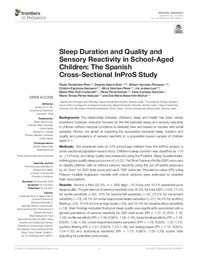Título :
Sleep duration and quality and sensory reactivity in school -aged children. The Spanis cross-sectional InProS study |
Autor :
Fernández Pires, Paula
Valera-Gran, Desirée
HURTADO-POMARES, MIRIAM
Espinosa-Sempere, María Cristina 
Sánchez-Pérez, Alicia
Juárez Leal, Iris
Ruiz-Carbonell, María-Pilar
Peral-Gómez, Paula
Campos Sánchez , Irene 
PÉREZ VÁZQUEZ, MARÍA TERESA 
Navarrete-Muñoz, Eva María  |
Editor :
Frontiers Media |
Departamento:
Departamentos de la UMH::Patología y Cirugía |
Fecha de publicación:
2021-07-05 |
URI :
https://hdl.handle.net/11000/31289 |
Resumen :
Background: The relationship between children’s sleep and health has been widely examined; however, research focused on the link between sleep and sensory reactivity in children without medical conditions is relatively new and based on studies with small samples. Hence, we aimed at exploring the association between sleep duration and quality and prevalence of sensory reactivity in a population-based sample of children
aged 3–7.
Methods: We examined data on 579 school-age children from the InProS project, a cross-sectional population-based study. Children’s sleep duration was classified as <10 vs. ≥10 h/day, and sleep quality was measured using the Pediatric Sleep Questionnaire, defining poor quality sleep as a score of ≥0.33. The Short Sensory Profile (SSP) was used to classify children with or without sensory reactivity using the cut-off points proposed
by W. Dunn for SSP total score and each SSP subscale. Prevalence ratios (PR) using Poisson multiple regression models with robust variance were estimated to examine main associations. Results: Around a third (32.6%; n = 189) slept <10 h/day and 10.4% presented poor sleep quality. The prevalence of sensory reactivity was 29.5%for total SSP (<155), 11.4% for tactile sensitivity (<30), 15% for taste/smell sensitivity (<15), 22.5% for movement sensitivity (<13), 49.1% for under-responsive/seeks sensation (<27), 44.4% for auditory filtering (<23), 12.4%for low energy/weak (<26), and 25.4%for visual/auditory sensitivity (<19). Main findings indicated that poor sleep quality was significantly associated with a greater prevalence of sensory reactivity for SSP total score (PR = 1.27; IC 95%: 1.18; 1.38), tactile sensitivity (PR = 1.09, IC95%: 1.00–1.19), taste/smell sensitivity (PR = 1.18, IC95%: 1.08–1.30), under-responsive/seeks sensation (PR = 1.28, IC95%: 1.20–1.37),
auditory filtering (PR = 1.31, IC95%: 1.23–1.39), low energy/weak (PR = 1.14, IC95%: 1.04–1.25) and audiovisual sensitivity (PR = 1.15, IC95%: 1.05–1.26) scores after adjusting for potential confounders. Conclusions: In this study, we observed that poor sleep quality was statistically significantly associated with a higher prevalence of sensory reactivity as measured by the total SSP and almost all SSP subscales. To our knowledge, this is the first time that this association has been explored and reported. Further research from prospective studies is required to confirm these findings.
|
Palabras clave/Materias:
sleep duration
sleep quality
sensory processing
short sensory profile
childhood
sensory reactivity |
Tipo documento :
application/pdf |
Derechos de acceso:
info:eu-repo/semantics/openAccess
Attribution-NonCommercial-NoDerivatives 4.0 Internacional |
DOI :
10.3389/fped.2021.646011 |
Aparece en las colecciones:
Artículos Patología y Cirugía
|

 La licencia se describe como: Atribución-NonComercial-NoDerivada 4.0 Internacional.
La licencia se describe como: Atribución-NonComercial-NoDerivada 4.0 Internacional.
.png)